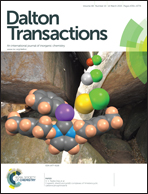Protonation of bridging sulfur in cubanoid Fe4S4 clusters causes large geometric changes: the theory of geometric and electronic structure.†
Abstract
Density functional calculations indicate that protonation of a μ3-S atom in cubanoid clusters [Fe4S4X4]2− leads to a large extension of one Fe–S(H) bond such that the SH ligand is doubly-bridging, μ-SH. Triply-bridging SH in these clusters is unstable, relative to μ-SH. The theory for the geometric and electronic structures of the protonated [Fe4S4X4]2− clusters (X = Cl, SEt, SMe, SPh, OMe, OPh) is presented in this paper. The principal results are (1) the unique Fe atom in [Fe4S3(SH)X4]− is three-coordinate, with planar or approximately planar stereochemistry, (2) approximately equi-energetic endo and exo isomers occur for pyramidal μ-SH, (3) the structural changes caused by protonation reverse without barrier on deprotonation, (4) the most stable electronic states have S = 0 and oppositely signed spin densities on the Fe atoms bearing the μ-SH bridge, (5) interconversions between endo and exo isomers, and between ground and excited states, occur through concerted lengthenings and shortenings of Fe–S(H) interactions, on relatively flat energy surfaces, (6) protonation of an X ligand does not change the characteristics of protonation of μ3-S. Experimental tests of this theory are suggested, and applications discussed.


 Please wait while we load your content...
Please wait while we load your content...